The K+ channel KIR2.1 functions in tandem with proton influx to mediate sour taste transduction
- PMID: 26627720
- PMCID: PMC4720319
- DOI: 10.1073/pnas.1514282112
The K+ channel KIR2.1 functions in tandem with proton influx to mediate sour taste transduction
Abstract
Sour taste is detected by a subset of taste cells on the tongue and palate epithelium that respond to acids with trains of action potentials. Entry of protons through a Zn(2+)-sensitive proton conductance that is specific to sour taste cells has been shown to be the initial event in sour taste transduction. Whether this conductance acts in concert with other channels sensitive to changes in intracellular pH, however, is not known. Here, we show that intracellular acidification generates excitatory responses in sour taste cells, which can be attributed to block of a resting K(+) current. We identify KIR2.1 as the acid-sensitive K(+) channel in sour taste cells using pharmacological and RNA expression profiling and confirm its contribution to sour taste with tissue-specific knockout of the Kcnj2 gene. Surprisingly, acid sensitivity is not conferred on sour taste cells by the specific expression of Kir2.1, but by the relatively small magnitude of the current, which makes the cells exquisitely sensitive to changes in intracellular pH. Consistent with a role of the K(+) current in amplifying the sensory response, entry of protons through the Zn(2+)-sensitive conductance produces a transient block of the KIR2.1 current. The identification in sour taste cells of an acid-sensitive K(+) channel suggests a mechanism for amplification of sour taste and may explain why weak acids that produce intracellular acidification, such as acetic acid, taste more sour than strong acids.
Keywords: gustatory; inward rectifier; potassium channel; proton channel; taste cell.
Conflict of interest statement
The authors declare no conflict of interest.
Figures


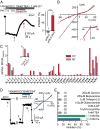

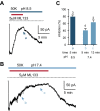




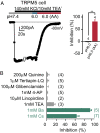


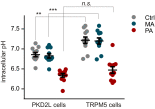
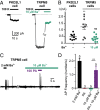

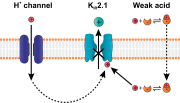

Comment in
-
Sour taste finds closure in a potassium channel.Proc Natl Acad Sci U S A. 2016 Jan 12;113(2):246-7. doi: 10.1073/pnas.1523319113. Epub 2015 Dec 30. Proc Natl Acad Sci U S A. 2016. PMID: 26719421 Free PMC article. No abstract available.
Similar articles
-
A proton current associated with sour taste: distribution and functional properties.FASEB J. 2015 Jul;29(7):3014-26. doi: 10.1096/fj.14-265694. Epub 2015 Apr 9. FASEB J. 2015. PMID: 25857556 Free PMC article.
-
Sour taste stimuli evoke Ca2+ and pH responses in mouse taste cells.J Physiol. 2003 Mar 1;547(Pt 2):475-83. doi: 10.1113/jphysiol.2002.033811. Epub 2003 Jan 17. J Physiol. 2003. PMID: 12562903 Free PMC article.
-
A proton current drives action potentials in genetically identified sour taste cells.Proc Natl Acad Sci U S A. 2010 Dec 21;107(51):22320-5. doi: 10.1073/pnas.1013664107. Epub 2010 Nov 23. Proc Natl Acad Sci U S A. 2010. PMID: 21098668 Free PMC article.
-
Taste receptors in the gastrointestinal tract III. Salty and sour taste: sensing of sodium and protons by the tongue.Am J Physiol Gastrointest Liver Physiol. 2006 Dec;291(6):G1005-10. doi: 10.1152/ajpgi.00235.2006. Epub 2006 Jun 29. Am J Physiol Gastrointest Liver Physiol. 2006. PMID: 16809639 Review.
-
Identification of sour-taste receptor genes.Anat Sci Int. 2003 Dec;78(4):205-10. doi: 10.1046/j.0022-7722.2003.00062.x. Anat Sci Int. 2003. PMID: 14686475 Review.
Cited by
-
Targeting Chemosensory Ion Channels in Peripheral Swallowing-Related Regions for the Management of Oropharyngeal Dysphagia.Int J Mol Sci. 2020 Aug 27;21(17):6214. doi: 10.3390/ijms21176214. Int J Mol Sci. 2020. PMID: 32867366 Free PMC article. Review.
-
Recent advances in taste transduction and signaling.F1000Res. 2019 Dec 17;8:F1000 Faculty Rev-2117. doi: 10.12688/f1000research.21099.1. eCollection 2019. F1000Res. 2019. PMID: 32185015 Free PMC article. Review.
-
Taste buds: cells, signals and synapses.Nat Rev Neurosci. 2017 Aug;18(8):485-497. doi: 10.1038/nrn.2017.68. Epub 2017 Jun 29. Nat Rev Neurosci. 2017. PMID: 28655883 Free PMC article. Review.
-
Potassium-sensitive loss of muscle force in the setting of reduced inward rectifier K+ current: Implications for Andersen-Tawil syndrome.Proc Natl Acad Sci U S A. 2025 Apr;122(13):e2418021122. doi: 10.1073/pnas.2418021122. Epub 2025 Mar 26. Proc Natl Acad Sci U S A. 2025. PMID: 40138348 Free PMC article.
-
Epitope Tagging with Genome Editing in Mice Reveals That the Proton Channel OTOP1 Is Apically Localized and Not Restricted to Type III "Sour" Taste Receptor Cells.J Neurosci. 2025 Feb 5;45(6):e1560242024. doi: 10.1523/JNEUROSCI.1560-24.2024. J Neurosci. 2025. PMID: 39592233 Free PMC article.
References
Publication types
MeSH terms
Substances
Grants and funding
- P30 DC004657/DC/NIDCD NIH HHS/United States
- F32 DC013971-01/DC/NIDCD NIH HHS/United States
- R01 HL121706/HL/NHLBI NIH HHS/United States
- P01 HL095488/HL/NHLBI NIH HHS/United States
- T32 HD041697/HD/NICHD NIH HHS/United States
- R21 DC012747/DC/NIDCD NIH HHS/United States
- R01 DC013741/DC/NIDCD NIH HHS/United States
- R01 DC012555/DC/NIDCD NIH HHS/United States
- P30 NS048154/NS/NINDS NIH HHS/United States
- HL121706/HL/NHLBI NIH HHS/United States
- P01 HL-095488/HL/NHLBI NIH HHS/United States
- F32 DC013971/DC/NIDCD NIH HHS/United States
- R37 DK053832/DK/NIDDK NIH HHS/United States
- R37 DK-053832/DK/NIDDK NIH HHS/United States
- R01 HL044455/HL/NHLBI NIH HHS/United States
LinkOut - more resources
Full Text Sources
Other Literature Sources
Molecular Biology Databases

